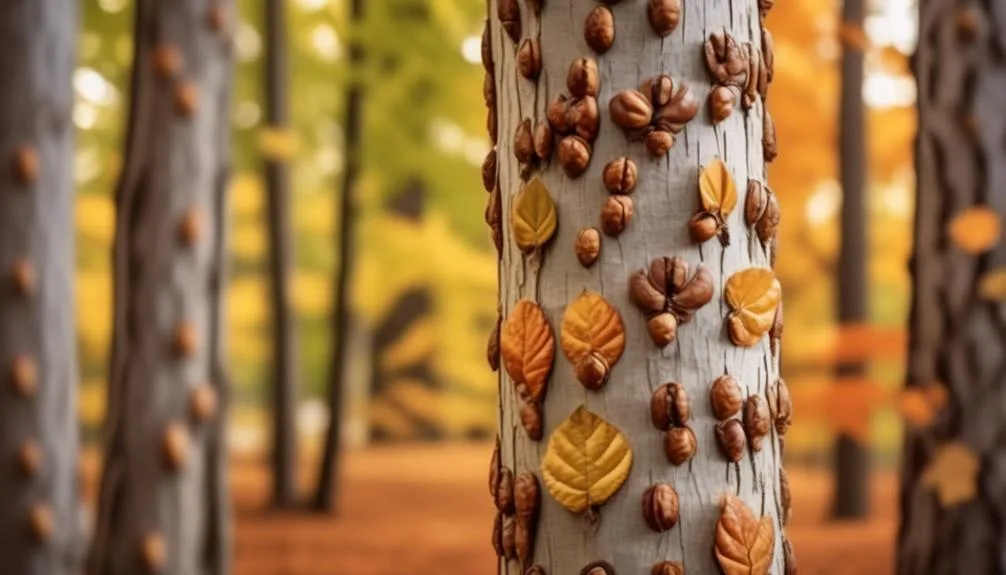When selecting a hickory tree variety, it's important to consider factors like climate, soil, nut, and timber qualities. Understanding these aspects will help you make an informed decision for your specific needs.
By the end of this discussion, you'll have the knowledge to choose the perfect hickory tree variety for your landscape.
Consider the Climate and Soil
Have you considered the specific climate and soil conditions in your area when choosing a hickory tree variety?
Hickory trees thrive in various climate zones, but it's crucial to select a variety that can withstand the specific conditions in your location. Consider the average temperature, rainfall, and humidity levels in your area to ensure the hickory tree variety you choose can thrive.
Additionally, soil composition plays a significant role in the success of hickory trees. Different hickory varieties have specific soil preferences, so understanding your soil type is essential. Whether your soil is sandy, loamy, or clay-based, there's a hickory tree variety suited to your soil composition.
Evaluate Tree Size and Growth Rate
Considering the specific climate and soil conditions in your area, it's important to evaluate the size and growth rate of the hickory tree variety you choose.
Understanding the growth patterns of different hickory tree varieties will help you determine which one best suits your needs. Some varieties, such as the Shagbark Hickory, can reach a height of 70-90 feet, while others, like the Shellbark Hickory, tend to be smaller, reaching 60-80 feet.
It's crucial to consider tree maintenance and pruning techniques, especially if you have limited space. Additionally, assessing soil fertility and drainage in your area is essential, as it directly impacts the growth rate of your hickory tree.
Assess Nut and Timber Qualities
Assessing the nut and timber qualities of different hickory tree varieties will help you determine which one best suits your needs and preferences. When considering nut production, some hickory varieties, such as the Shellbark and Shagbark hickory, are known for their excellent nut yield, making them ideal choices if you desire a hickory tree for its edible nuts. Alternatively, if you prioritize wood strength for timber, the Bitternut hickory is highly valued for its exceptionally strong and durable wood, making it a great option for timber production. Here's a table to help you compare nut and timber qualities:
| Hickory Variety | Nut Production | Wood Strength |
|---|---|---|
| Shellbark Hickory | High | Moderate |
| Shagbark Hickory | High | Moderate |
| Bitternut Hickory | Low | High |
Explore Disease and Pest Resistance
To ensure the health and longevity of your chosen hickory tree variety, it's essential to thoroughly evaluate its resistance to diseases and pests. When exploring disease and pest resistance, consider the following:
- Disease Resistance: Look for hickory tree varieties known for their resistance to common diseases such as leaf spot and powdery mildew. Disease-resistant trees are better equipped to thrive in various environmental conditions and require less maintenance.
- Pest Control: Investigate the tree's natural defenses against pests like borers and caterpillars. Choose varieties that have shown resilience against common hickory tree pests, reducing the need for chemical pest control methods.
- Soil Health and Climate Impact: Understand how the tree variety interacts with different soil types and climates. Some varieties may be more adaptable to specific soil conditions and climate variations, enhancing their overall resistance to diseases and pests.
Factor in Space and Maintenance Requirements
When selecting a hickory tree variety, it's crucial to factor in its space and maintenance requirements to ensure optimal growth and health.
Space planning is essential as hickory trees can vary widely in size, from smaller types like the pecan hickory to larger varieties such as the shellbark hickory. Consider the mature height and spread of the tree to ensure it has ample room to thrive without overcrowding.
Understanding the pruning techniques specific to the chosen hickory variety is vital for its maintenance. Regular pruning helps shape the tree, removes dead or diseased branches, and promotes healthy growth.
It's important to learn about the pruning needs of the specific hickory tree variety you choose to ensure you can provide the necessary care for its optimal development.
Conclusion
In your search for the perfect hickory tree variety, consider your climate, soil, tree size, nut and timber qualities, and maintenance needs.
By carefully weighing these factors, you can find the ideal hickory tree variety to enhance your property.
Whether it's for shade, nuts, or aesthetic appeal, there's a hickory tree variety suited just for you.
Happy planting and may your chosen hickory tree thrive and bring joy to your surroundings for years to come.

My interest in trees started when I first saw the giant sequoias in Yosemite.
I was a teenager then, and I remember thinking, “I need to learn more about this.”
That moment stuck with me.
A few years later, I went on to study forestry at Michigan Tech.
Since graduating, I’ve worked in a mix of hands-on tree care and community education.
I’ve spent over ten years helping people understand how to plant, maintain, and protect the trees in their neighborhoods.
I don’t see trees as just part of the landscape.
They are living things that make a real difference in our daily lives.
